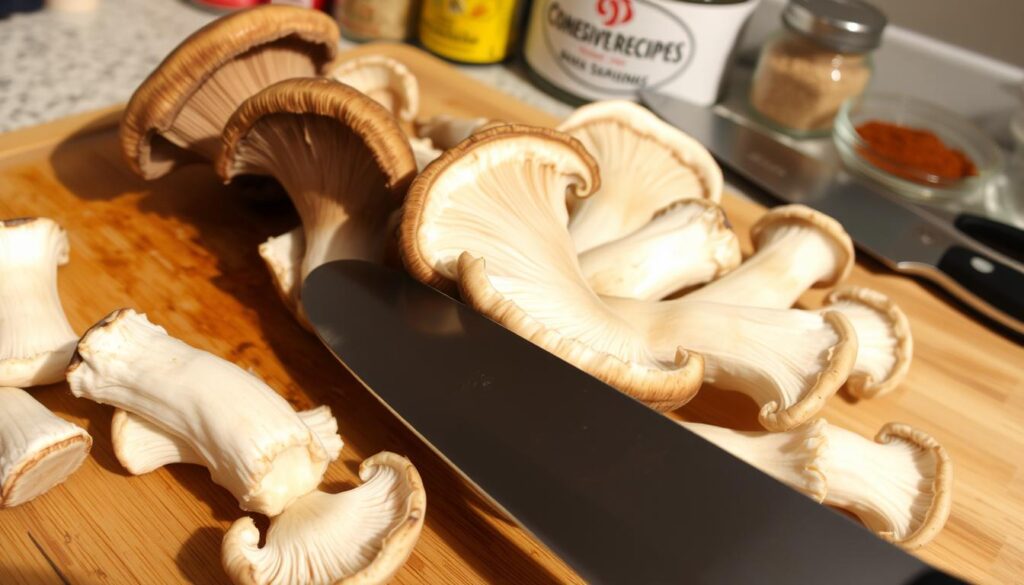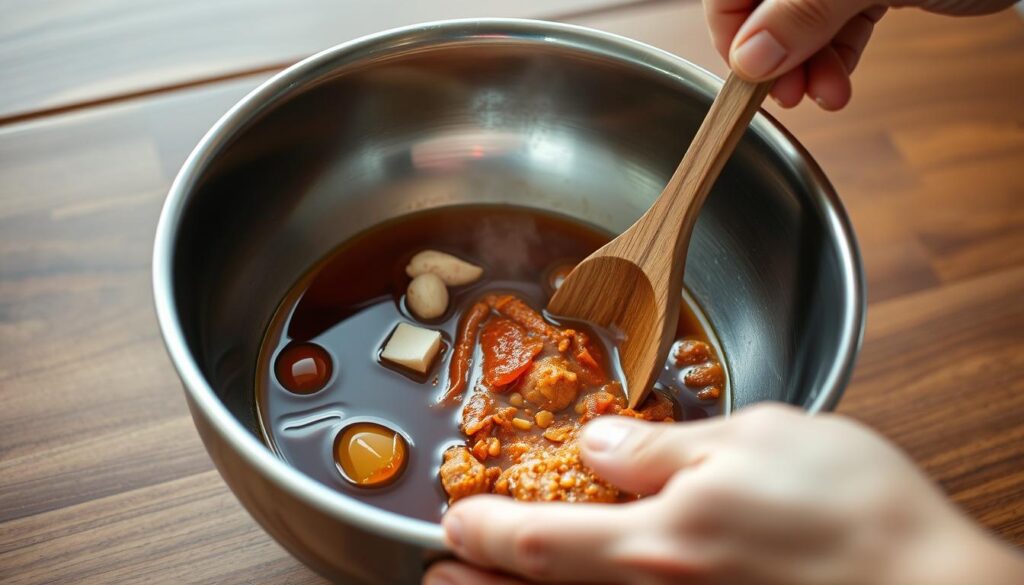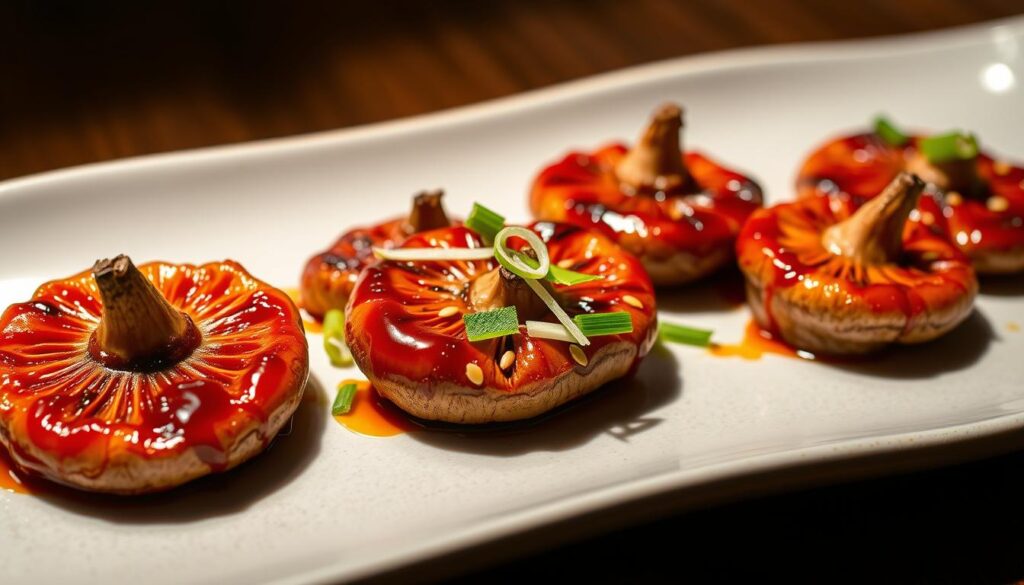Last summer, I had a dish at the Pacific Rim restaurant on a Regent Seven Seas cruise that changed my view of vegetarian food. A sizzling plate came with thick mushroom slices and a glossy red sauce. One bite was amazing, with earthy flavors and spicy-sweet notes.
The chef told me it was eryngii mushrooms, grilled in a Korean way. I’d never tried them before.
This dish isn’t just for cruise ships. Eryngii mushrooms, also called “king trumpet,” are great for grilling. They have a meaty texture that’s perfect for charred perfection on your grill.
When you add gochujang, Korea’s chili paste, they become a gourmet mushroom recipe. It’s so good, even meat lovers love it. Now, fancy restaurants in LA and NYC serve this dish, showing that plant-based meals can be exciting.
Key Takeaways
- Eryngii mushrooms offer a meaty texture ideal for grilling
- Gochujang adds complex spicy-sweet flavors to vegetarian dishes
- This recipe combines Korean flavors with gourmet dining techniques
- Popular in upscale venues like Regent Seven Seas’ Pacific Rim restaurant
- A healthy alternative to traditional grilled meats
- Balances umami richness with vibrant chili kick
Why Eryngii Mushrooms Shine on the Grill
Grilling turns eryngii mushrooms into tasty wonders, just like meat dishes. Their thick texture and natural umami are perfect for grilling. They pair well with bold flavors like gochujang. Let’s see why they’re a hit for vegetarian grilling.
The Unique Qualities of King Oyster Mushrooms
Eryngii mushrooms have thick stems and delicate caps. They keep their moisture while grilling, getting a nice crust. This makes them a top choice in kitchens, even in dishes like Pacific Rim’s Korean barbecue lamb chop.
Here’s why they’re great for grilling:
- Low water content: They don’t shrink or get mushy
- Vertical grain: They soak up marinades well
- Heat resistance: They stay firm at high heat
Nutritional Benefits of Grilled Eryngii
These mushrooms are a nutritional powerhouse for health-conscious grillers. A 100g serving has only 35 calories but offers 3g of protein and 2g of fiber. Grilling boosts their vitamin D, a rare plus for plants.
| Nutrient | Raw Eryngii | Grilled Eryngii |
|---|---|---|
| Vitamin D (IU) | 28 | 112 |
| Potassium (mg) | 367 | 349 |
| Calories | 33 | 35 |
Grilling makes their flavor richer and keeps antioxidants. They have 80% less saturated fat than grilled beef. Their versatility makes them a hit in dishes, pleasing both meat-lovers and vegans.
Understanding Gochujang: Korea’s Flavor Powerhouse
Imagine a condiment that combines heat, sweetness, and depth. That’s gochujang. It’s a fermented chili paste that turns simple ingredients into umami-rich masterpieces.
The Anatomy of Gochujang Paste
Traditional gochujang is made from three main ingredients: gochugaru (Korean chili flakes), fermented soybean powder, and sticky rice. The fermentation process, which lasts months, creates complex flavors. These range from sweet to smoky.
Pacific Rim Gourmet’s chefs say:
“Quality gochujang should hit your tongue with warmth first, then reveal layers of savory depth – never just flat heat”
If you’re gluten-free, choose brands that use rice syrup instead of wheat. The right gochujang clings to your spoon without grittiness, showing it’s aged well.
Building a Balanced Glaze
To make the perfect spicy mushroom glaze, balance four elements:
- Heat: Gochujang base (start with 2 tbsp)
- Sweet: Honey or maple syrup (1.5 tbsp)
- Tang: Rice vinegar (1 tbsp)
- Salt: Soy sauce or tamari (1 tsp)
Pro tip: Whisk in 1 tsp sesame oil for a scent that’s like Seoul street food. For more Korean BBQ vibes, add minced garlic before brushing on mushrooms.
Remember, great glazes get better on the grill. Sugars caramelize, chili mellows, and what starts as a simple sauce becomes the flavor bridge between smoky mushrooms and your taste buds.
Essential Tools for Perfect Grilled Mushrooms
Great grilled eryngii starts with the right gear. Whether you’re cooking for a backyard BBQ or a plant-based feast, professional-grade tools make all the difference. Let’s break down the essentials that turn ordinary grilling into a restaurant-worthy experience.
Grill Setup Recommendations
Charcoal or gas? Both work, but each has perks. Charcoal grills deliver smoky depth perfect for savory mushroom dishes, while gas offers precise temperature control. Cruise ship chefs swear by these setup tips:
- Create two heat zones (hot for searing, medium for finishing)
- Preheat grates 15 minutes before cooking
- Use cast iron grates for better caramelization
| Feature | Charcoal Grill | Gas Grill |
|---|---|---|
| Heat Control | Manual adjustment | Precise dials |
| Flavor Profile | Smoky richness | Clean & consistent |
| Setup Time | 20-30 minutes | 5-10 minutes |
Must-Have Utensils
Upgrade your toolkit with these BBQ essentials:
- 14″ stainless steel tongs (non-scratch tips)
- Grill brush with scraper & bristle guard
- Perforated grill tray for small mushroom slices
- Infrared thermometer (accuracy matters!)
Pro tip: Look for NSF-certified tools used in commercial kitchens. They handle high heat better than standard BBQ gear and last through countless easy grilled vegetable recipes.
Selecting and Prepping Eryngii Mushrooms
Learning to grill eryngii mushrooms starts before they hit the grill. These meaty fungi need careful handling to reach their best. Whether you’re making a healthy mushroom recipe or a gourmet vegetarian recipe, here’s how to prepare them perfectly.

Choosing Prime Specimens
Top chefs from Pacific Rim kitchens follow three key rules for choosing the best eryngii:
- Firm caps with minimal browning
- Stems that feel dense, not hollow
- A subtle earthy aroma (avoid overly pungent mushrooms)
Look for mushrooms with stems of even thickness for even cooking. The best ones for your vegetarian grilling ideas will have a glossy look, showing they’re fresh.
Proper Cleaning Techniques
Eryngii mushrooms need a gentle touch because of their dense structure:
- Wipe caps with a slightly damp cloth
- Use a soft brush on textured stem surfaces
- Trim only the very bottom of the stem (save trimmings for stocks!)
Don’t soak these mushrooms. Their sponge-like texture soaks up water fast, leading to steaming instead of searing. To control moisture, pat-dry with paper towels twice: once before slicing, once after.
Strategic Slicing Methods
The way you cut the mushrooms affects the crust. For how to grill eryngii mushrooms like a pro:
- 1/2″ thick cross-sections create ideal charring surfaces
- Lengthwise splits showcase the stem’s scallop-like texture
- Angled cuts increase glaze adhesion points
Cruise ship chefs use a special cross-hatch technique. They make shallow diagonal cuts on both sides of thick slices. This helps the glaze stick while keeping the mushrooms firm during grilling.
Crafting the Perfect Gochujang Glaze
Turn your grilled eryngii mushrooms into a Korean-inspired dish with a special glaze. This sauce mixes old flavors with new grilling methods. It makes a sweet, spicy, and umami crust that sticks well to the mushrooms.
Base Ingredients Breakdown
The best glaze starts with top-notch ingredients. Gochujang paste gives it a spicy-sweet taste. Rice vinegar adds a bright note. Here’s a look at homemade and store-bought options:
| Ingredient | Homemade Advantage | Store-Bought Benefit |
|---|---|---|
| Gochujang | Customizable heat level | Time-saving option |
| Sweetener | Use local honey or maple | Pre-measured consistency |
| Aromatics | Fresh garlic/ginger | Pre-minced convenience |
Step-by-Step Mixing Process
- Combine ¼ cup gochujang with 2 tbsp rice vinegar in a bowl
- Whisk in 1 tbsp sesame oil and 1 tsp grated ginger
- Slowly add 3 tbsp honey until it’s fully dissolved
- Check the consistency – it should coat the back of a spoon
Heat customization tip: For a milder taste, cut gochugaru (Korean chili flakes) in half. Add ½ tsp smoked paprika for more depth. For a cool look, put the glaze in squeeze bottles for easy use.
Let the mix sit for 15 minutes before using. This lets the flavors blend while you get the grill ready. The glaze should be thick but still pourable, giving it a glossy finish like in restaurants.
Marinating for Maximum Flavor
Learning to marinate turns ordinary grilled eryngii into something special. It’s not just about adding taste—it’s where texture and umami enhancement come alive. In kitchens from Seoul to cruise ships, marinating is a precise art. We’ll explore how timing and tools affect your dish.
Timing Considerations
Eryngii mushrooms soak up flavors and soften quickly. Cruise ship chefs marinate proteins for 24 hours. But mushrooms need much less time:
| Marinating Time | Texture Change | Flavor Intensity |
|---|---|---|
| 30 minutes | Slight softening | Mild |
| 1-2 hours | Velvety surface | Balanced |
| 4+ hours | Overly tender | Overpowering |

Container Selection Tips
Your choice of container affects flavor and ease. Here are meal prep strategies from the pros:
- Shallow glass dishes: Ensure even coating without crowding
- Reusable silicone bags: Great for fridge storage and mixing marinade
- Vacuum-seal containers: A cruise ship favorite for quick flavor absorption
Stay away from metal bowls, as they can react with acidic glaze ingredients. For the best Korean-inspired grilled dish, marinate in the fridge and dry mushrooms before grilling.
Grilling Techniques for Perfect Char
Get deep smoky flavors and perfect grill marks with strategic temperature zoning. Professional kitchens, like those with Pacific Rim-inspired open grills, use controlled heat. This creates amazing bbq mushroom dishes. Let’s explore how to turn eryngii into masterfully charred dishes.
Fire Management Essentials
Set up a two-zone fire setup like cruise ship grill stations. Use a searing zone (400-450°F) for initial charring and a moderate zone (325-375°F) for finishing. For charcoal grills:
- Pile coals 2 layers deep on one side
- Spread single layer on the opposite side
Gas grill users: Set burners to high on one half, medium-low on the other. Use an infrared thermometer to check surface temps. Mushrooms react quickly to uneven heat!
Step-by-Step Grilling Process
- Preheat grill grates 10 minutes (prevents sticking)
- Brush eryngii with neutral oil using long-handled tongs
- Sear 2 minutes per side over high heat zone
- Move to moderate zone, glaze with gochujang mixture
- Cook 4-5 minutes until caramelized
Pro Tip: Rotate mushrooms 90° after first minute for crosshatch grill marks. Baste only during final 2 minutes to prevent burning the sugar-rich glaze.
Doneness Indicators
Watch for these key doneness indicators:
| Visual | Tactile | Temporal |
|---|---|---|
| Golden-brown edges | Slight resistance when pressed | 6-7 minutes total |
| Glaze caramelization | Springs back slowly | Juices bubble at edges |
Use the finger test: Gently press the mushroom’s center. Properly cooked eryngii should feel like the fleshy part below your thumb when hand’s relaxed – firm but yielding. Overcooked mushrooms become tough; undercooked ones feel spongy.
Plating and Presentation Ideas
The right plating can turn grilled eryngii into a restaurant-quality plating experience. We’ll see how to show off the mushroom’s texture and the glossy gochujang glaze. This is done through careful design.

Modern Korean-Inspired Arrangements
Bring Pacific Rim vibes by making abstract lotus motifs. Place thick mushroom slices in circles on banana leaves or slate plates. For a dramatic look:
- Start with roasted garlic puree as the base “soil”
- Use vertical mushroom stacks for height
- Drizzle glaze in artistic strokes
Garnish Game Elevators
Edible flower garnishes bring instant elegance. Try these pairings:
| Element | Traditional | Modern Twist |
|---|---|---|
| Base | White ceramic | Burnt wood slab |
| Color Accent | Green onion curls | Chili thread nests |
| Texture | Sesame seeds | Crispy lotus root chips |
End with microgreens at one edge for a balanced look. A mist of sesame oil boosts the glaze’s shine and aroma.
Adapting the Recipe for Dietary Needs
Modern cooking is all about being inclusive. This grilled eryngii dish can be made for many different diets. It’s perfect for gatherings where everyone has different needs or allergies. Everyone can enjoy the smoky-sweet taste of Korean grilling.
Vegan Version Modifications
Plant-based grilling fans can easily change this recipe. Just make three simple swaps:
- Swap honey for maple syrup or agave nectar in the glaze
- Choose vegan gochujang (some have fish powder)
- Use mushroom broth instead of dashima stock
Big cruise lines like Regent Seven Seas show how these changes work well. They use similar steps for their vegan menus. To get the right texture, brush the mushrooms with sesame oil before grilling. This helps when you don’t use animal products.
Gluten-Free Adjustments
For gluten-free Korean recipes, focus on two things:
- Use tamari instead of regular soy sauce (make sure it’s 100% soybean)
- Choose gluten-free gochujang (many brands now offer rice-based options)
These changes keep the dish’s umami flavor while being safe for gluten allergies. To avoid cross-contamination, clean the grill grates well or use a special grill basket. This is what professional kitchens do for guests with gluten sensitivities.
With these vegan BBQ options and gluten-safe tweaks, you’ll make a dish that’s full of flavor. It’s something everyone can enjoy. It shows that cooking for allergies can be incredibly tasty.
Complementary Side Dishes
Grilled eryngii mushrooms with gochujang glaze need sides that balance their smoky heat. Pacific Rim’s wok-fried beans add a crisp texture and nutty flavor. Their sesame oil finish makes the dish even more special.
For lighter options, try banchan-inspired sides like pickled daikon. They cut through richness with their tangy brightness.
Quick kimchi variations are great for busy cooks. Try napa cabbage with gochugaru, fish sauce, and rice vinegar for a 20-minute ferment. Pair it with coconut rice steamed in bamboo leaves for a sweet contrast.
Crunch lovers should try Asian slaw recipes. Mix shredded kale, matchstick apples, and toasted almonds. Dress it with lime juice and chili oil for a zesty kick.
Don’t forget about texture. Steamed buns or lettuce cups let guests build their own bites. For gatherings, offer small bowls of roasted seaweed strips and sesame seeds. These DIY garnishes add a personal touch while keeping flavors true to their roots.